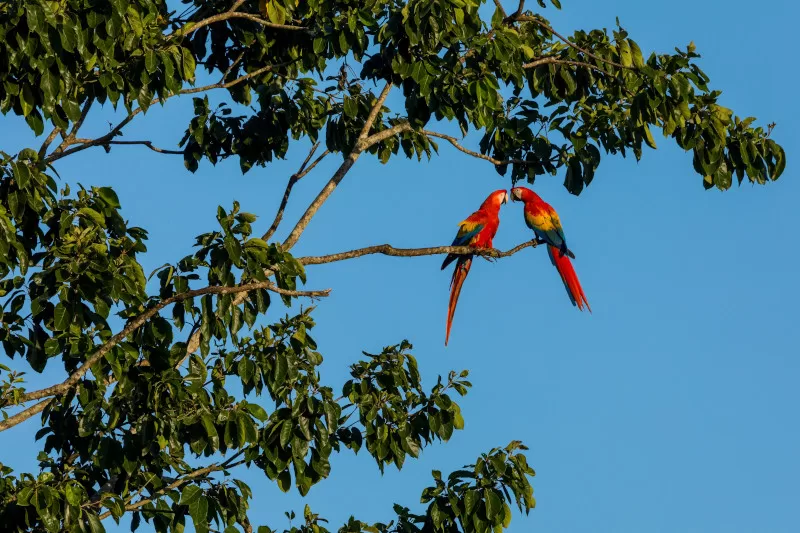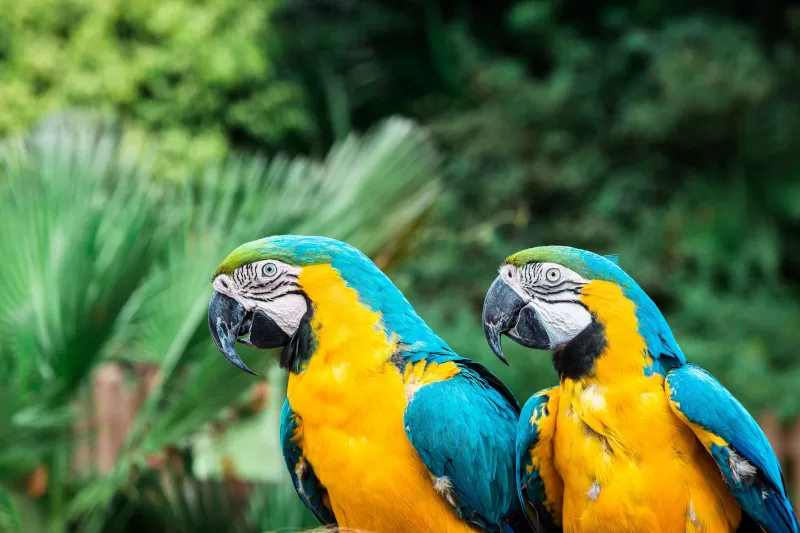Nestled deep in the heart of the Peruvian Amazon, a spectacle of color, sound, and natural wonder awaits visitors at the Macaw Clay Lick in Manu National Park. This enthralling natural phenomenon, where hundreds of vibrantly colored macaws gather to feed on mineral-rich clay, is a testament to the park’s extraordinary biodiversity and ecological importance.
The Macaw Clay Lick provides a mesmerizing display, one that offers an unparalleled window into the intricate relationships of the rainforest’s animal inhabitants and their unique adaptations to this lush environment. This article will guide you through the fascinating details of the Macaw Clay Lick’s function in the avian world, the incredible species that depend on it, and how this natural spectacle fits into the broader, breathtaking tapestry of Manu National Park.
When embarking on a Manu Amazon Tour, one standout attraction is the Macaw Clay Lick. What draws hundreds of macaws to this site? The answer lies in the rainforest’s unique diet.
The Macaw Clay Lick is a mineral-rich wall of clay, located along the riverbanks. It’s no ordinary feeding spot. Instead, it serves as nature’s mineral buffet for these vibrant birds.
During a Manu Rainforest Tour, you’ll witness a spectacular scene. Dawn paints the sky as countless macaws descend onto the clay lick. Their quest is not for regular food, but for vital minerals.
The clay provides macaws with essential sodium. This mineral is scarce in their regular diet of seeds and fruits. However, it’s crucial for their survival, driving them to visit the clay lick.
Moreover, the clay helps neutralize the toxins found in their diet. Some fruits and seeds in the rainforest are toxic. Yet, the Macaw Clay Lick offers a solution to this challenge.
Macaws, along with other parrot species, have a unique way of dealing with toxins. They ingest clay from the Clay Lick to detoxify their system. It’s a remarkable natural adaptation.
Visitors to Manu National Park can observe this phenomenon firsthand. The spectacle of macaws at the clay lick is a testament to nature’s intricate workings. This captivating scene reveals a deep-seated relationship between animals and their environment.
The Clay Lick is more than a stunning spectacle. It is a crucial part of the macaws’ survival strategy in the challenging Amazonian landscape. It’s nature’s perfect remedy for a mineral-deprived diet and a detoxifying solution.

A Manu Jungle Tour is incomplete without visiting the Macaw Clay Lick. Here, the rainforest’s avian spectacle unfolds in a riot of colors. It’s a bird watcher’s paradise.
The stars of this spectacle are, undoubtedly, the macaws. They are large, vibrantly colored parrots, known for their long tails and strong beaks. Their captivating appearance draws attention from afar.
At the Macaw Clay Lick, you’ll witness different species of macaws. They include the blue-and-yellow macaw, scarlet macaw, and red-and-green macaw. Each species flaunts unique color patterns, creating an impressive chromatic array.
Blue-and-yellow macaws feature vibrant blue wings and tail. Their bodies are a brilliant yellow, creating a stark contrast. These are the largest macaws you’ll see at the clay lick.
Scarlet macaws are stunning with their fiery red plumage. Hints of yellow and blue on their wings add to their beauty. Their loud calls echo throughout the rainforest.
Red-and-green macaws, less brightly colored, add to the spectacle’s diversity. Their green upper bodies blend into red lower bodies and tails. Despite the more subdued colors, they are no less fascinating.
But the Clay Lick isn’t exclusive to macaws. Other parrots and parakeets are regular visitors too. These include the dusky-headed parakeet and the mealy parrot. They join the macaws in the quest for mineral-rich clay.
The variety of birds creates a vibrant, bustling scene at the Macaw Clay Lick. Their shared need for minerals connects these diverse species. This daily gathering highlights the interconnectedness of the rainforest’s inhabitants.
Macaw Clay Licks host an array of birds. Their shared dietary need for minerals creates a unique spectacle. A visit here guarantees a memorable close-up with Manu’s vibrant avian life.

A Manu Reserved Zone Tour reveals both the challenges and triumphs in the park’s conservation journey. Central to this tale is the Macaw Clay Lick.
Manu National Park hosts remarkable biodiversity, making its protection vital. However, this has not been without challenges. Deforestation, illegal hunting, and climate change pose constant threats.
The Macaw Clay Lick, being a significant ecological spot, faces these threats too. Illegal logging can disrupt the birds’ habitat, reducing their numbers. Hunting is another issue, threatening these bird populations.
Despite these challenges, there have been many conservation triumphs. Notably, the park’s recognition as a UNESCO World Heritage Site has increased its protection. International attention has bolstered the park’s conservation efforts.
Efforts to protect the Macaw Clay Lick specifically have also been fruitful. Constant monitoring and research on macaws’ behavior help inform conservation strategies. These measures have contributed to the site’s continued existence.
Eco-tourism, done responsibly, is another triumph. Tourist visits, like to the Macaw Clay Lick, fund conservation efforts. Increased global awareness also motivates broader protective measures.
Education programs have been key as well. These programs aim to teach locals about the park’s value. The objective is to inspire locals to protect treasures like the Macaw Clay Lick.
However, conservation is an ongoing journey. The future of Manu National Park and its Macaw Clay Lick lies in sustained effort. Balance between human activity and nature’s needs is crucial.
Thus, the Macaw Clay Lick stands as both a challenge and triumph. Conservation efforts are continually striving to protect this unique spectacle. The park’s future depends on our continued commitment to preservation.

If you got any questions, please do not hesitate to send us a message. We reply within 24 hours!
+51 900 394 399
info@biomanuexpeditions.com
reservas@biomanuexpeditions.com
